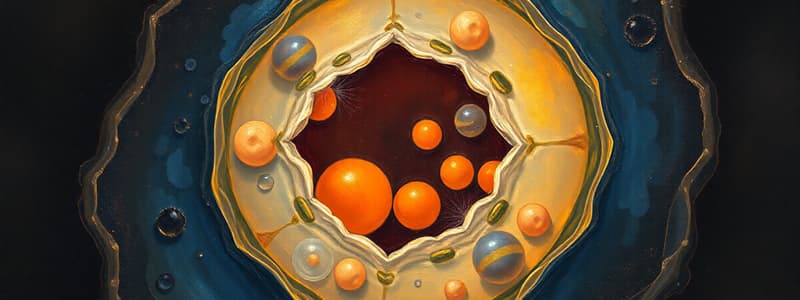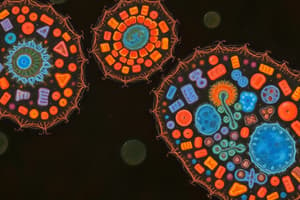Podcast
Questions and Answers
What role do plasma cells play in the body?
What role do plasma cells play in the body?
- They synthesize lipids.
- They regulate the cell cycle.
- They store nutrients.
- They secrete antibodies. (correct)
Which organelle contains amplified amounts of rough ER in plasma cells?
Which organelle contains amplified amounts of rough ER in plasma cells?
- Rough ER (correct)
- Golgi apparatus
- Plasma membrane
- Mitochondria
What happens to the Golgi apparatus when microtubules are depolymerized?
What happens to the Golgi apparatus when microtubules are depolymerized?
- It fragments and disperses. (correct)
- It forms a dense cluster.
- It increases in size.
- It becomes more efficient.
How do organelle locations in a cell typically depend on their interactions?
How do organelle locations in a cell typically depend on their interactions?
What feature is crucial for the function of organelles like the ER and Golgi apparatus?
What feature is crucial for the function of organelles like the ER and Golgi apparatus?
What type of ER is associated with lipid synthesis?
What type of ER is associated with lipid synthesis?
What is the characteristic arrangement of organelles in the cytoplasm often controlled by?
What is the characteristic arrangement of organelles in the cytoplasm often controlled by?
What evolutionary aspect can help explain the relationships of organelles?
What evolutionary aspect can help explain the relationships of organelles?
What is the primary role of the cytosol in a eukaryotic cell?
What is the primary role of the cytosol in a eukaryotic cell?
What distinguishes rough endoplasmic reticulum (ER) from smooth ER?
What distinguishes rough endoplasmic reticulum (ER) from smooth ER?
What is the primary function of mitochondria?
What is the primary function of mitochondria?
Where do proteins synthesized on ribosomes associated with the rough ER go immediately after synthesis?
Where do proteins synthesized on ribosomes associated with the rough ER go immediately after synthesis?
Which organelle is specialized for photosynthesis?
Which organelle is specialized for photosynthesis?
What is the main function of peroxisomes in eukaryotic cells?
What is the main function of peroxisomes in eukaryotic cells?
What structural feature is present in the Golgi apparatus?
What structural feature is present in the Golgi apparatus?
What process must materials undergo before reaching lysosomes after endocytosis?
What process must materials undergo before reaching lysosomes after endocytosis?
Which of the following statements about peroxisomes is correct?
Which of the following statements about peroxisomes is correct?
Which of the following correctly describes the process of protein transport into membrane-enclosed organelles?
Which of the following correctly describes the process of protein transport into membrane-enclosed organelles?
In highly specialized cells, what best describes the regulation of membrane-enclosed organelles?
In highly specialized cells, what best describes the regulation of membrane-enclosed organelles?
What role does the endoplasmic reticulum (ER) play in lipid production?
What role does the endoplasmic reticulum (ER) play in lipid production?
What is a key feature of the Golgi apparatus's function?
What is a key feature of the Golgi apparatus's function?
What percentage of a cell's total volume is typically occupied by membrane-enclosed compartments?
What percentage of a cell's total volume is typically occupied by membrane-enclosed compartments?
Which organelle contains digestive enzymes for degrading macromolecules?
Which organelle contains digestive enzymes for degrading macromolecules?
Which organelle's membrane surface area is significantly larger in liver cells compared to plasma membrane?
Which organelle's membrane surface area is significantly larger in liver cells compared to plasma membrane?
What characterizes the function of proteins within intracellular compartments?
What characterizes the function of proteins within intracellular compartments?
Which statement about eukaryotic cells is accurate?
Which statement about eukaryotic cells is accurate?
How are proteins directed to specific organelles in a cell?
How are proteins directed to specific organelles in a cell?
What is primarily synthesized in the cytosol of a eukaryotic cell?
What is primarily synthesized in the cytosol of a eukaryotic cell?
What role do complex distribution systems play in eukaryotic cells?
What role do complex distribution systems play in eukaryotic cells?
Which of the following occurs as a central theme in the chapter?
Which of the following occurs as a central theme in the chapter?
What is the primary characteristic of organelles in a eukaryotic cell?
What is the primary characteristic of organelles in a eukaryotic cell?
Mitochondria and chloroplasts are distinguished from other organelles by their:
Mitochondria and chloroplasts are distinguished from other organelles by their:
What is the primary function of membrane-bound enzymes in eukaryotic cells?
What is the primary function of membrane-bound enzymes in eukaryotic cells?
What role do intracellular membrane systems play within eukaryotic cells?
What role do intracellular membrane systems play within eukaryotic cells?
Which statement accurately describes the relationship between organelle membranes and metabolites?
Which statement accurately describes the relationship between organelle membranes and metabolites?
What is a critical aspect of organelle membranes in eukaryotic cells?
What is a critical aspect of organelle membranes in eukaryotic cells?
How do membranes contribute to processes like oxidative phosphorylation and photosynthesis?
How do membranes contribute to processes like oxidative phosphorylation and photosynthesis?
Which of the following compartments is NOT mentioned as an important structure in an animal cell?
Which of the following compartments is NOT mentioned as an important structure in an animal cell?
What defines the unique functions of different organelles within eukaryotic cells?
What defines the unique functions of different organelles within eukaryotic cells?
What is the significance of the lipid bilayer of cell membranes in terms of hydrophilic molecules?
What is the significance of the lipid bilayer of cell membranes in terms of hydrophilic molecules?
Flashcards are hidden until you start studying
Study Notes
The Compartmentalization of Cells
- Eukaryotic cells are subdivided into functionally distinct membrane-enclosed compartments called organelles.
- Each organelle houses a unique set of enzymes and molecules.
- To understand the eukaryotic cell, it is essential to know how these compartments are created, maintained, and how molecules move between them.
- The synthesis of proteins begins in the cytosol, the space of the cytoplasm outside the membrane-enclosed organelles.
- Each newly synthesized protein is then delivered to the organelle that requires it.
- The central theme for this chapter is the intracellular transport of proteins.
Understanding the Origins of Organelles
- The relationships between the compartments of the cell can be understood by considering how they may have evolved.
What do Organelles Do?
- Plasma Cells: Secrete their own weight in antibody molecules into the bloodstream every day. Contain large amounts of rough ER, found in large, flat sheets.
- Cells that specialize in lipid synthesis: Expand their ER to form a network of convoluted tubules.
- Golgi Apparatus: Located near the nucleus.
- ER Tubules: Extend from the nucleus throughout the entire cytosol.
- Microtubules: Support the localization of the ER and Golgi apparatus. If they are depolymerized, the Golgi apparatus fragments and disperses throughout the cell, and the ER network collapses.
- Size, Shape, Composition, and Location: All are regulated features of organelles that contribute to their function.
Function of the Main Organelles
- Nucleus: Contains the genome (excluding mitochondrial and chloroplast DNA). Principal site of DNA and RNA synthesis.
- Cytoplasm: Consists of the cytosol and cytoplasmic organelles.
- Cytosol: Main site of protein synthesis and degradation. Performs most of the cell’s intermediary metabolism.
- Endoplasmic Reticulum (ER): Occupies a large portion of the cell's membrane surface area. Responsible for protein synthesis, lipid production, and storage of Ca2+ ions.
- Rough ER: Contains ribosomes bound to its cytosolic surface and synthesizes proteins destined for secretion or other organelles.
- Smooth ER: Lacks bound ribosomes. Functions in lipid synthesis and Ca2+ storage.
- Golgi Apparatus: Receives proteins and lipids from the ER and dispatches them to various destinations, often modifying them en route.
- Mitochondria and Chloroplasts: Generate most of the cell’s ATP.
- Chloroplasts: Function as the main sites of photosynthesis.
- Lysosomes: Contain digestive enzymes that degrade intracellular organelles, macromolecules, and particles taken up by endocytosis.
- Endosomes: Intermediate organelles between the plasma membrane and lysosomes.
- Peroxisomes: Small, vesicular compartments that contain enzymes involved in oxidative reactions.
Organelle Variations
- Each membrane-enclosed organelle performs the same set of basic functions in all cell types.
- Organelles vary in abundance and properties to meet the specialized functions of different cell types.
- In liver and pancreatic cells, the endoplasmic reticulum has a larger membrane surface area than the plasma membrane.
- The abundance and shape of membrane-enclosed organelles are regulated to meet the needs of the cell.
Studying That Suits You
Use AI to generate personalized quizzes and flashcards to suit your learning preferences.




